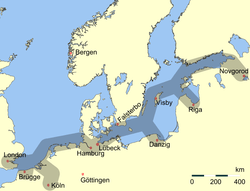Nijmegen
| Nijmegen Nimeguen | |||
|---|---|---|---|
| City and municipality | |||
|
Nijmegen city view from the north west | |||
| |||
.svg.png) Location in Gelderland | |||
| Coordinates: 51°51′N 5°52′E / 51.850°N 5.867°ECoordinates: 51°51′N 5°52′E / 51.850°N 5.867°E | |||
| Country | Netherlands | ||
| Province | Gelderland | ||
| Founded | 98 | ||
| Founded by | Trajan | ||
| Government[1] | |||
| • Body | Municipal council | ||
| • Mayor | Hubert Bruls (CDA) | ||
| Area[2] | |||
| • Municipality | 57.60 km2 (22.24 sq mi) | ||
| • Land | 53.62 km2 (20.70 sq mi) | ||
| • Water | 3.98 km2 (1.54 sq mi) | ||
| Elevation[3] | 29 m (95 ft) | ||
| Highest elevation | 88 m (289 ft) | ||
| Lowest elevation | 7 m (23 ft) | ||
| Population (Municipality, May 2014; Urban and Metro, May 2014)[4][5] | |||
| • Municipality | 168,840 | ||
| • Density | 3,149/km2 (8,160/sq mi) | ||
| • Urban | 168,840 | ||
| • Metro | 287,517 | ||
| Demonym(s) | Nijmegenaar | ||
| Time zone | CET (UTC+1) | ||
| • Summer (DST) | CEST (UTC+2) | ||
| Postcode | 6500–6547, 6679, 6683 | ||
| Area code | 024, 0481 | ||
| Website |
www | ||
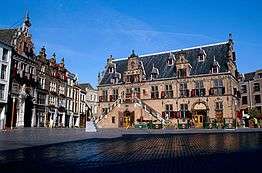

Nijmegen (Dutch pronunciation: [ˈnɛimeːɣə(n)];[6] Nijmeegs: Nimwegen [ˈnɪmβ̞ɛːxə]), historically anglicized as Nimeguen,[7] is a municipality and a city in the Dutch province of Gelderland. It is situated on the Waal river, close to the German border.
Nijmegen is the oldest city in the Netherlands, the first to be recognized as such in Roman times, and in 2005 celebrated 2,000 years of existence.
The municipality is part of the "Stadsregio Arnhem-Nijmegen" (Arnhem-Nijmegen urban region (neighbouring city, 15 km (9 mi) north)), a metropolitan area with 736,107 inhabitants (2011).
Population centres
The municipality is formed by the city of Nijmegen, incorporating the former villages of Hatert, Hees and Neerbosch, as well as the urban expansion project of Waalsprong, situated north of the river Waal and including the village of Lent and the hamlet of 't Zand, as well as the new suburbs of Nijmegen-Oosterhout and Nijmegen-Ressen.
History
| Historical population | ||
|---|---|---|
| Year | Pop. | ±% p.a. |
| 1400 | 10,800 | — |
| 1500 | 12,000 | +0.11% |
| 1560 | 10,000 | −0.30% |
| 1611 | 11,780 | +0.32% |
| 1651 | 8,160 | −0.91% |
| 1741 | 12,000 | +0.43% |
| 1795 | 11,008 | −0.16% |
| Source: Lourens & Lucassen 1997 | ||
The first mention of Nijmegen in history is in the 1st century BC, when the Romans built a military camp on the place where Nijmegen was to appear; the location had great strategic value because of the surrounding hills, which gave (and continue to give) a good view over the Waal and Rhine valley.
By 69, when the Batavians, the original inhabitants of the Rhine and Maas delta, revolted, a village called Oppidum Batavorum had formed near the Roman camp. This village was destroyed in the revolt, but when it had ended the Romans built another, bigger camp where the Legio X Gemina was stationed. Soon after, another village formed around this camp.
In 98, Nijmegen was the first of two settlements in what is now the Kingdom of the Netherlands to receive Roman city rights.[8]
In 103, the X Gemina was re-stationed to Vindobona, modern day Vienna, which may have been a major blow to the economy of the village around the camp, losing around 5000 inhabitants. In 104 Emperor Trajan renamed the town, which now became known as Ulpia Noviomagus Batavorum, Noviomagus for short (the origin of the current name Nijmegen).
Beginning in the second half of the 4th century, Roman power decreased and Noviomagus eventually became part of the Frankish kingdom. It has been contended that in the 8th century Emperor Charlemagne maintained his palatium in Nijmegen on at least four occasions. During his brief deposition of 830, the emperor Louis the Pious was sent to Nijmegen by his son Lothar I. Thanks to the Waal river, trade flourished.
The powerful Henry VI, Holy Roman Emperor was born at Nijmegen in 1165. In 1230 his son Frederick II, Holy Roman Emperor granted Nijmegen city rights. In 1247, the city was ceded to the count of Guelders as collateral for a loan. The loan was never repaid, and Nijmegen has been a part of Gelderland ever since. This did not hamper trade; Nijmegen even became part of the Hanseatic League in 1364.
The arts also flourished in this period. Famous medieval painters like the Limbourg brothers were born and educated in Nijmegen.
During the Dutch Revolt, trade came to a halt and even though Nijmegen became a part of the Republic of United Provinces in 1585, it remained a border town and had to endure multiple sieges.
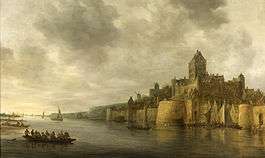
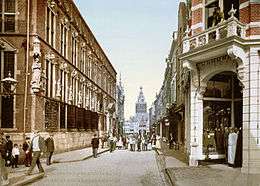
In 1678 Nijmegen was host to the negotiations between the European powers that aimed to put an end to the constant warfare that had ravaged the continent for years. The result was the Treaty of Nijmegen that, unfortunately, failed to provide for a lasting peace.
In the second half of the 19th century, the fortifications around the city became a major problem. There were too many inhabitants inside the walls, but the fortifications could not be demolished because Nijmegen was deemed as being of vital importance to the defence of the Netherlands. When events in the Franco-Prussian war proved that old-fashioned fortifications were no more of use, this policy was changed and the fortifications were dismantled in 1874. The old castle had already been demolished in 1797, so that its bricks could be sold.
Through the second half of the 19th century and the first half of the 20th century, Nijmegen grew steadily. The Waal was bridged in 1878 by a rail bridge and in 1936 by a car bridge, which was claimed to be Europe's biggest bridge at the time. In 1923 the current Radboud University Nijmegen was founded and in 1927 a channel was dug between the Waal and Maas rivers.
In 1940, the Netherlands was invaded by Germany with Nijmegen being the first Dutch city to fall into German hands. On 22 February 1944, Nijmegen was heavily bombed by American planes, causing great damage to the city centre. It was subsequently claimed by the Allies that the American pilots thought they were bombing the German city of Kleve, while the Germans alleged that it was a planned operation authorised by the Dutch government in exile. The Dutch organization for investigating wartime atrocities, the NIOD, announced in January 2005 that its study of the incident confirmed that it was an accident caused by poor communications and chaos in the airspace. Over 750 people died in the bombardment.
During September 1944, the city saw heavy fighting during Operation Market Garden. The objective in Nijmegen was mainly to prevent the Germans from destroying the bridges. Capturing the road bridge allowed the British Army XXX Corps to attempt to reach the 1st British Airborne Division in Arnhem. The bridge was heavily defended by over 300 German troops on both the north and south sides with close to 20 anti-tank guns and two anti-aircraft guns, supported with artillery.
The Germans' late attempt to blow the road bridge was possibly foiled by a local Dutch resistance hero, Jan van Hoof, who is said to have cut the wires to the bridge.
The Germans made repeated attacks on the bridge using bombs attached to driftwood, midget submarines and later resorted to shelling the bridge with 88mm barrages. Troops were positioned on the bridge giving an excellent arc of fire in case of attack. Troops that couldn't fit onto the bridge were positioned in a bombed-out house slightly upstream of the bridge. During the shelling, the house was hit, killing six soldiers and wounding one more.
Nijmegen was liberated from German occupation by the British Grenadier Guards of the Guards Armoured Division, as well as elements of the American 82nd Airborne Division in September 1944. The city would later be used as a springboard for Operation Veritable, the invasion across the Rhine River by Allied Troops.
More recently, on 23 February 1981, the Nijmegen Police Department and the Dutch Army stormed the Piersonstraat and Zeigelhof, a squatted housing block in the city centre of Nijmegen. Using 200 riot vans, three Leopard MBTs, three armoured personnel carriers, a helicopter, 1200 policemen, and 750 members of the armed forces, they evicted the squatters and demolished the block, while clouding the entire area in teargas and CS gas. This received enormous backlash in local politics. While the city government wanted the squatters out to build a parking garage, most of the population wanted affordable housing to be built in the area.
As of this date, Nijmegen is still known as Havana on the Waal among some Right-wingers. The Socialist Party, the Green Party and Labour have a solid two-thirds majority in City Council, making Nijmegen the only major city in the Netherlands with a solely Left-wing government. The current mayor is Hubert Bruls.
Nijmegen celebrated its 2000th year of existence in 2005. It is considered the oldest city in the Netherlands. In gaining this qualification, it has competed with the city of Maastricht.
In November 2005, the city centre of Nijmegen was the site of the assassination of political activist Louis Sévèke by a former activist (Marcel T.). Marcel T. was arrested in 2007 in Spain and extradited to the Netherlands. Marcel T. was also accused of bank robbery. Marcel T. committed his acts out of revenge for a forcible eviction from the squatter scene by Louis Sévèke.
Sights
Historical remains

Few Roman remains are visible today; a fragment of the old city wall can be seen near the casino and the foundations of the amphitheatre are traced in the paving of the present-day Rembrandtstraat. The Valkhof museum, on the Valkhof, has a permanent display of the history of Nijmegen, including artifacts from the Roman era. Additionally, they usually have temporary exhibitions of more and less famous artists. Not many very old buildings are left in town: first the Americans carpet-bombed it in February 1944, later the Germans shelled it for about five months after the liberation in September 1944, and finally there were a number of vigorous city planners in the 1950s, 60s and 70s who finished the demolition. There are still a few noteworthy sights, however. Valkhof hill downtown features a Carolingian chapel (eighth, ninth century AD) and a small remainder of an imperial castle that was demolished in 1798.
Museums in and around Nijmegen
- Africa Museum (African art and culture)
- Museum Park Orientalis (focuses on the (joined) origin of Judaism, Christianity and Islam)
- Valkhof museum (Roman and medieval history and modern art)
- Velorama (bicycle museum)
- Bevrijdingsmuseum (about World War II and the airlandings at Nijmegen)
- House of the History of Nijmegen information centre about the history of Nijmegen; free entrance; expositions about a theme of the town's history; touch screen which leads you to the 50 highlights of the towns'history: 'Canon of Nijmegen'; reading table. The House of the Nijmegen History is situated in a unique mediaeval chapel 'de Mariënburgkapel'; its mission is to let enjoy people of the history of the town and to be a guide for everybody who wants to visit the oldest city of the Netherlands. There is also a digital House. NijmegenWiki)
- Nature Museum Nijmegen (about nature around the rivers in the province of Gelderland)
Events
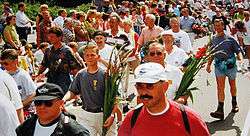
Four Days Marches
Nijmegen has long been known for its annual Four Days Marches (Dutch: Nijmeegse Vierdaagse), beginning on the third Tuesday of each July. Participants undertake four days of walking distances ranging from 30 km (19 miles) to 50 km (31 miles). The marches are supplemented with festivities such as de-Affaire and draw participants from as far away as Britain, Canada, the USA, Australia, and New Zealand. On average, there are 40,000 participants from 30 countries.
A piece of music that's often sung and played during the marches is the "Four-Days March", specially composed by H.A. van Mechelen in 1932 [9]
Culture
Religion
In 1968, prominent liberal theologians in the Roman Catholic Church issued what is now known as the Nijmegen Statement, demanding sweeping reforms in the Vatican's Holy Office, previously known as The Inquisition, and calling for greater scope for theological inquiry. Among its signatories was the then progressive theologian Fr. Joseph Ratzinger, then a member of the faculty at the University of Tübingen but later a much more conservative figure as the head of the successor to the Holy Office, the Congregation for the Doctrine of the Faith, and later still Pope Benedict XVI.
The Nijmegen Statement said: "Any form of Inquisition however subtle, not only harms the development of sound theology, it also causes irreparable damage to the credibility of the church". The signatories, a group of predominantly German-speaking theologians asserted that "the freedom of theologians, and theology in the service of the church, regained by Vatican II, must not be jeopardised again." The signatories pledged their loyalty to the Pope, but argued that the teaching office of pope and bishops "cannot and must not supersede, hamper and impede the teaching task of theologians as scholars."
There are several English-language religious meetings in Nijmegen. See the external link for a list of church services in English (the link from the official site is obsolete as it has not being updated for some time).
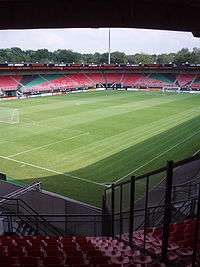
Sport
Sport in the city is principally focused on its football club N.E.C. Nijmegen or just NEC, short for Nijmegen Eendracht Combinatie, which plays at the 12,500 seat Stadion de Goffert. The club used to be in the top division, the Eredivisie, however in 2013–14 they were relegated to the Eerste Divisie. In 2015 after 1 year Eerste Divisie they were promoted as champions back to the Eredivisie.
Bandy Vereniging Nijmegen is the biggest bandy club in the country.
The city is also home to one of the country's oldest cricket clubs, Quick 1888, a current member of the KNCB. Formed in 1888, the club is the largest cricket club in the east of the country and was formed 13 years after the first club, Utile Dulci from Deventer. The cricket club has both men's and women's teams.
The city also has the Nijmegen Devils, an Ice hockey club.
Nijmegen also plays host to the annual Zevenheuvelenloop (Seven Hills Run), an annual 15 km (9 mi) run recognised by the IAAF as a Bronze Label race.
Politics
| Party | seats | change from 2010 |
|---|---|---|
| SP (Socialists) | 8 | +3 |
| GroenLinks (Greens) | 8 | 0 |
| D66 (Liberal Democrats) | 7 | +1 |
| PvdA (Labor) | 4 | -4 |
| VVD (Liberal Conservatives) | 3 | -1 (split) |
| Gewoon Nijmegen | 2 | 0 |
| CDA (Christian-Democrats) | 2 | -1 |
| De Nijmeegse Fractie | 2 | +1 |
| VSP | 2 | +1 |
| Liberaal Nijmegen | 1 | +1 (new group, split from VVD) |
The city council has 39 seats. After the 2002 municipal elections, the three major parties, GroenLinks (9 seats), PvdA (8 seats) and SP (6 seats) formed a coalition. Because these are all left-wing parties, Nijmegen received the nickname 'Havana on the Waal'. Although such majorities are no exception (compare Amsterdam) and sometimes also form coalitions (see Muntendam), this is unusual for a city this size. Since such a left-wing coalition might be possible at a national level after the 2006 general election, the achievements of this council are often scrutinised. After the 2006 municipal election such a coalition became possible in many more municipalities, making the example even more interesting.
The municipal elections of 7 March 2006 saw an increase of 4,6% of the votes for these three parties taken together, which could be seen as increased support for the coalition. However, nationally these parties scored much better, recovering from an electoral blow of the 2002 elections. Then again, the Leefbaar parties that caused the loss then and lost most of their votes this time have no branch in Nijmegen, which makes this comparison less valid. Among the three big parties, there was a shift from GroenLinks, who lost 6.5%, to PvdA, who won 6.4% and SP, who won 2.3%. As a result, it is no longer the biggest party. The seat assignment is now as shown in the table. The three-party coalition was returned to office.
After the 2010 Dutch municipal election, the PvdA lost three of its eleven seats. Short before the elections, there were problems with the SP. Therefore, GroenLinks and the PvdA formed a coalition with the social-liberal D66.
The municipal elections of 19 March 2014 saw the Socialist Party narrowly becoming the largest party in the Nijmegen city council after gaining three more seats. The Greens were only some 200 votes behind, while the Liberal Democrats (D'66) gained another seat, while Labour lost half their support, becoming as small as the liberal-conservative VVD. The coalition government was formed between the three centre-left and leftist parties SP, GroenLinks and PvdA, and a local party called The Nijmegen Group (De Nijmeegse Fractie). It also had informal support from the United Senior Party (VSP).
Later in 2014, a city council member of the VVD, Paul Eigenhuijsen, left the VVD group. The former leader of the group, Hayke Veldman, had gone to the House of Representatives, and thus left the city council. Eigenhuijsen had been second on the party list, but he was not elected to the position of leader. Thereafter, he left the group and started his own one-man group, called Liberal Nijmegen.
Education
Nijmegen is host to Radboud University Nijmegen. Founded in 1923 as the first Catholic university in the Netherlands, it used to be called Catholic University of Nijmegen until 2004, when it took its current name. As of 2013, it had 18,891 students and 5,050 staff. Radboud University runs the High Field Magnetic Laboratory which is able to achieve some of the highest fields available in Europe at 38 teslas (continuous). The facility is available to outside users, primarily for research purposes.
The education and social work departments of the HAN University of Applied Sciences, school for higher-level vocational training are also located in Nijmegen, as are that school's medical departments.
In addition to these institutions, there is also an intermediate-level vocational school (ROC Nijmegen) and a number of secondary schools: Groenschool Nijmegen, Kandinsky College, Nijmeegse Scholengemeenschap Groenewoud (NSG), Citadel College, Stedelijke Scholengemeenschap Nijmegen (SSGN), Canisius College, St. Jorisschool, Mondial College, the Stedelijk Gymnasium (formally the "Latijnse school", founded in the 16th century), the Karel de Grote College, Montessori College and the Dominicus College. Of note is also Leefwerkschool Eigenwijs, which caters to students from all over the Netherlands who have been repeatedly expelled from "regular" high schools. Leefwerkschool Eigenwijs has its roots in the local activist movement of the early 1980s and is the only school of its kind recognised in the Netherlands.
Nijmegen is also an important centre of Psycholinguistics, home to the Max Planck Institute of Psycholinguistics and the Donders Institute for Brain, Cognition and Behaviour.
The Nobel Prize for Physics in 2010 was awarded to Andre Geim and Konstantin Novoselov while at Radboud University "for groundbreaking experiments regarding the two-dimensional material graphene."
Nature
Parks
| Goffertpark |
Kronenburgerpark in winter |
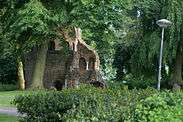 Valkhof Park |
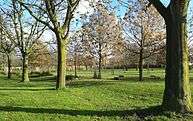 Park West at Hees |
More room for the river Waal
To prevent flooding in the near future, the Dutch government is changing the course of more than 30 rivers throughout the country. These measures, taken along the rivers IJssel, Lek, Maas and Waal, are known as ‘Room for the River’. Room for the river Waal as it passes Nijmegen is one of these measures. As part of this, the artificial island Veur-Lent was created in 2015.
The river Waal not only has a sharp bend near Nijmegen, it also forms a bottleneck. In 1993 and 1995 this led to high water and floods. To prevent this from happening again and to protect inhabitants of the city and its surroundings against the water, work has been done to relocate the Waal dike in Lent and to excavate a large ancillary channel in the flood plains, creating an island in the Waal. The large scale project involves the construction of three bridges, new dikes and concrete water barriers. On the island, a project of alleged sustainable urbanism is giving birth to an urban river park with possibilities for recreation, culture, water and nature.[10]
Climate
Nijmegen is one of the warmest cities of the Netherlands, especially during summer, when the highest temperatures in the country are usually measured in the triangle Roermond – Nijmegen – Eindhoven. The lack of north-south oriented mountain ranges in Europe make this area prone to sudden shifts in weather, giving the region a semi-continental climate.
Some of the northernmost wineries in the world are found just outside Nijmegen, around Groesbeek, a suburban village south-east of Nijmegen.
During the 2006 European heat wave, closest official weather station Volkel reached a high of 36.7 °C (98.1 °F) on 19 July. The heat wave coincided with that year's Four Day Marches, which were cancelled after the first day, when two people died of hyperthermia-related causes. Temperatures on that day, 18 July, reached around 36 °C (96.8 °F) in the city.
Nijmegen is in USDA Hardiness zone 7b and AHS Heat zone 3.
In the following table the monthly precipitation is measured in Nijmegen itself, the monthly sunshine at nearby official weather station Deelen (25 kilometres (16 miles) north) and the other numbers at closest official weather station Volkel (23 km (14 mi) south-west).
| Climate data for Nijmegen, Netherlands (1971–2000) | |||||||||||||
|---|---|---|---|---|---|---|---|---|---|---|---|---|---|
| Month | Jan | Feb | Mar | Apr | May | Jun | Jul | Aug | Sep | Oct | Nov | Dec | Year |
| Record high °C (°F) | 15.0 (59) |
17.7 (63.9) |
23.0 (73.4) |
27.1 (80.8) |
31.9 (89.4) |
34.8 (94.6) |
36.7 (98.1) |
36.3 (97.3) |
31.0 (87.8) |
27.5 (81.5) |
18.4 (65.1) |
16.0 (60.8) |
36.7 (98.1) |
| Average high °C (°F) | 5.2 (41.4) |
6.2 (43.2) |
9.8 (49.6) |
13.3 (55.9) |
18.1 (64.6) |
20.4 (68.7) |
22.6 (72.7) |
22.9 (73.2) |
19.0 (66.2) |
14.3 (57.7) |
8.9 (48) |
6.2 (43.2) |
13.9 (57) |
| Daily mean °C (°F) | 2.6 (36.7) |
2.9 (37.2) |
5.8 (42.4) |
8.4 (47.1) |
12.9 (55.2) |
15.5 (59.9) |
17.5 (63.5) |
17.3 (63.1) |
14.1 (57.4) |
10.2 (50.4) |
6.0 (42.8) |
3.8 (38.8) |
9.8 (49.6) |
| Average low °C (°F) | −0.2 (31.6) |
−0.4 (31.3) |
1.7 (35.1) |
3.4 (38.1) |
7.4 (45.3) |
10.2 (50.4) |
12.2 (54) |
11.7 (53.1) |
9.4 (48.9) |
6.1 (43) |
2.8 (37) |
1.0 (33.8) |
5.4 (41.7) |
| Record low °C (°F) | −20.1 (−4.2) |
−15.3 (4.5) |
−13.7 (7.3) |
−7.4 (18.7) |
−1.7 (28.9) |
0.9 (33.6) |
3.8 (38.8) |
3.5 (38.3) |
−0.9 (30.4) |
−5.5 (22.1) |
−9.8 (14.4) |
−18.8 (−1.8) |
−20.1 (−4.2) |
| Average precipitation mm (inches) | 64.8 (2.551) |
42.7 (1.681) |
63.0 (2.48) |
44.4 (1.748) |
58.8 (2.315) |
74.3 (2.925) |
62.6 (2.465) |
56.2 (2.213) |
68.9 (2.713) |
66.2 (2.606) |
69.9 (2.752) |
72.3 (2.846) |
744.1 (29.295) |
| Average precipitation days | 22 | 17 | 21 | 18 | 17 | 18 | 17 | 17 | 18 | 19 | 21 | 22 | 227 |
| Average relative humidity (%) | 89 | 86 | 82 | 77 | 75 | 76 | 77 | 77 | 83 | 87 | 90 | 90 | 82 |
| Mean monthly sunshine hours | 47.4 | 74.1 | 105.7 | 151.7 | 193.5 | 172.5 | 183.1 | 182.9 | 127.4 | 102.8 | 55.8 | 40.0 | 1,436.9 |
| Source: Klimaatatlas van Nederland, normaalperiode 1971–2000, ISBN 90-389-1191-2 | |||||||||||||
Natives and residents
- See also People from Nijmegen
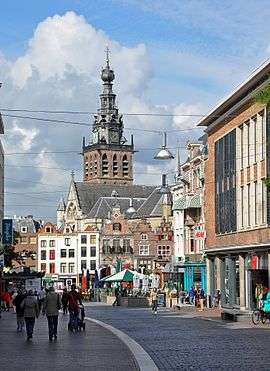
Natives
- Petrus Canisius (1521-1597), saint
- Henry VI, Holy Roman Emperor (1165-1197)
- Limbourg brothers, medieval painters
- Princess Margarita of Bourbon-Parma, member of the Dutch Royal Family
- Alex Van Halen (1953–present), rock musician
- Eddie Van Halen (1955–present), rock musician
- Jos Hermens (1950–present), athlete
- Pie Geelen (1972–present), Olympic swimmer
- Anne Quist (1957–present), Olympic rower
- Ron de Groot (1960–present), footballer
- Frank Demouge (1982–present), footballer
- Nacer Barazite, footballer
- Saadia Himi (1984–present), Miss Netherlands Earth 2004
Residents
- Titus Brandsma – Philosopher and Resistance Member
- Edward Ka-Spel – Vocalist of The Legendary Pink Dots
- Karapet Karapetyan – Kickboxer
- Dries van Agt – Politician
- Nina Simone – Jazz musician
- Perry Ubeda – Kickboxer
- Amira Willighagen – Opera Singer, at the age of 9 winner of 2013 Holland's Got Talent
Transport
Nijmegen has five train stations: Nijmegen, Nijmegen Dukenburg, Nijmegen Heyendaal, Nijmegen Lent and Nijmegen Goffert. The central station is connected to the national Intercity network. The bus company Breng (a subsidiary of Connexxion) operates the city buses in the Arnhem-Nijmegen metropolitan area.
Like most Dutch cities, bicycles are an important mode of transport. The city is connected to Arnhem, 18 km (11 mi) to the north, by a "fietssnelweg" (fast cycle highway) which crosses the Snelbinder bridge in the city. During 2010-2012 the cycle highway received upgrades to further encourage the use of bicycles for transport between Nijmegen and Arnhem.[11] In May 2016, the Dutch Fietsersbond (Cyclists' Union) awarded the 2016 Fietsstad (Cycling City) award to the city of Nijmegen.[12]
The river is a busy freight transport route, with barges to the city as well as passing through on the way between the industrial regions of Germany and the docks at Amsterdam, Rotterdam and Hook of Holland. The Maas-Waal Canal also carries freight through the city.
On 23 November 2013, a new bridge, de Oversteek (the Crossing), that connects the western part of the city to the northern shore, was opened. It relieves congestion of the old road bridge which was built in 1936. It is called de Oversteek since its built on the location of an important rivercrossing by the Allied forces during Operation Market Garden in WWII, September 1944. The plan was to liberate the Waalbrug from the northern shore, which they managed to do, but with great losses. The bridge was opened by two of the soldiers, a daughter of General Gavin made a speech and familymembers of WWII soldiers were present. To remember the 48 American soldiers that died, every night 48 pairs of streetlights will go on one by one, from north to south.[13]
KLM Royal Dutch Airlines operates a bus from the Nijmegen railway station to Schiphol Airport for KLM customers.[14]
International relations

Twin towns — sister cities
Nijmegen is twinned with:
References
- ↑ "Burgemeester" [Mayor] (in Dutch). Gemeente Nijmegen. Retrieved 10 June 2014.
- ↑ "Kerncijfers wijken en buurten" [Key figures for neighbourhoods]. CBS Statline (in Dutch). CBS. 2 July 2013. Retrieved 12 March 2014.
- ↑ "Postcodetool for 6511PP". Actueel Hoogtebestand Nederland (in Dutch). Het Waterschapshuis. Retrieved 10 June 2014.
- ↑ "Bevolkingsontwikkeling; regio per maand" [Population growth; regions per month]. CBS Statline (in Dutch). CBS. 26 June 2014. Retrieved 24 July 2014.
- ↑ "Bevolkingsontwikkeling; regio per maand" [Population growth; regions per month]. CBS Statline (in Dutch). CBS. 26 June 2014. Retrieved 24 July 2014.
- ↑ obsolete spellings: Nijmwegen, Nymegen, Nieumeghen — and in German, Nimègue in French, Nimega in Spanish and Italian
- ↑ Historic railway map of the Netherlands (must be before 1930), showing "Nimeguen"
- ↑ "Nijmegen oldest city".
- ↑ The Four-Days March on You Tube
- ↑ Project Room for the river Waal
- ↑ Hembrow, David (2010-10-04). "A view from the cycle path: Mobility man - cycle superhighway". Hembrow.blogspot.com. Retrieved 2013-03-26.
- ↑ "Gemeente Nijmegen uitgeroepen tot Fietsstad 2016" (in Dutch). Fietsersbond. 19 May 2016. Retrieved 19 May 2016.
- ↑ De Oversteek (dutch)
- ↑ "Travel by bus or rail with a KLM ticket." KLM. Retrieved on October 29, 2016.
- Literature
- Lourens, Piet; Lucassen, Jan (1997). Inwonertallen van Nederlandse steden ca. 1300–1800. Amsterdam: NEHA. ISBN 9057420082.
External links
| Wikimedia Commons has media related to Nijmegen. |
| Wikivoyage has a travel guide for Nijmegen. |
 |
Overbetuwe | Lingewaard |  | |
| Beuningen | |
Berg en Dal | ||
| ||||
| | ||||
| Wijchen | Heumen |



